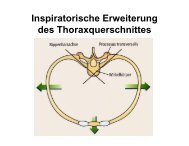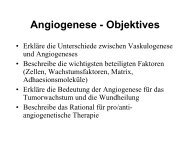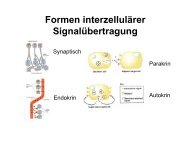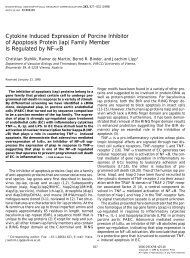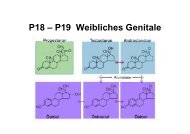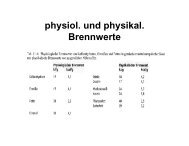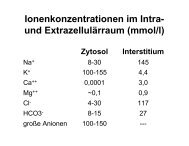Interleukin-33 Induces Expression of Adhesion Molecules and ...
Interleukin-33 Induces Expression of Adhesion Molecules and ...
Interleukin-33 Induces Expression of Adhesion Molecules and ...
Create successful ePaper yourself
Turn your PDF publications into a flip-book with our unique Google optimized e-Paper software.
2084 Arterioscler Thromb Vasc Biol September 2011<br />
8594). In agreement with published data, IL-6 <strong>and</strong> IL-8 protein<br />
production was also increased under IL-<strong>33</strong> treatment in both<br />
endothelial cell types (data not shown). 31<br />
Also in HCAEC, IL-<strong>33</strong> treatment dose-dependently increased<br />
ICAM-1 (Figure 2E), VCAM-1 (Figure 2F),<br />
E-selectin (Figure 2G), <strong>and</strong> MCP-1 protein (Figure 2H) after<br />
4 hours <strong>of</strong> incubation.<br />
As IL-<strong>33</strong> was shown to exert its effects by binding to<br />
cell surface T1/ST2, 13 we examined whether incubation<br />
with the soluble extracellular domain <strong>of</strong> ST2 coupled to the<br />
Fc fragment <strong>of</strong> human IgG 1 (sST2-Fc) could interfere with<br />
the stimulatory effect <strong>of</strong> IL-<strong>33</strong>. Indeed, sST2-Fc, but not<br />
IgG 1-Fc used as an isotype control, significantly inhibited<br />
the production <strong>of</strong> ICAM-1, VCAM-1, E-selectin, <strong>and</strong><br />
MCP-1 protein induced by IL-<strong>33</strong> in human endothelial<br />
cells (Supplemental Figure I). sST2-Fc does not affect<br />
basal production <strong>of</strong> any <strong>of</strong> these proteins (Supplemental<br />
Figure I).<br />
IL-<strong>33</strong> at a concentration <strong>of</strong> 100 ng/mL also robustly<br />
upregulated mRNA specific for ICAM-1, VCAM-1,<br />
E-selectin <strong>and</strong> MCP-1 in HUVEC between 1 hour <strong>and</strong> 9<br />
hours <strong>of</strong> incubation with maximal up-regulation between 3<br />
<strong>and</strong> 6 hours (please see Supplemental Figure II). Similarly,<br />
levels <strong>of</strong> mRNA specific for ICAM-1, VCAM-1,<br />
E-selectin, <strong>and</strong> MCP-1 were increased also in HCAEC<br />
after 9 hours <strong>of</strong> incubation with 100 ng/mL IL-<strong>33</strong><br />
12.0�5.1-fold, 17.9�4.1-fold, 246.2�51.9-fold, <strong>and</strong><br />
9.4�3.7-fold, respectively.<br />
We tested also for the effect <strong>of</strong> IL-<strong>33</strong> treatment on IL-1<br />
expression <strong>and</strong> found that IL-<strong>33</strong> also significantly upregulated<br />
IL-1 mRNA expression in both HUVEC <strong>and</strong> HCAEC<br />
(Supplemental Table I). Maximal upregulation <strong>of</strong> IL-1<br />
mRNA was achieved at 6 hours in HUVEC <strong>and</strong> at 3 hours in<br />
HCAEC (Supplemental Table I). Since ICAM-1, VCAM-1,<br />
E-selectin, <strong>and</strong> MCP-1 production may also depend on the<br />
autocrine action <strong>of</strong> IL-1, we determined the role <strong>of</strong> endogenous<br />
IL-1 in the production <strong>of</strong> these biomolecules by IL-<strong>33</strong>.<br />
We found no inhibitory effect <strong>of</strong> IL-1Ra (10 �g/mL) on<br />
IL-<strong>33</strong>-induced ICAM-1, VCAM-1, E-selectin, <strong>and</strong> MCP-1<br />
mRNA expression in HUVEC. In contrast, when used at the<br />
same concentration IL-1Ra completely inhibited IL-1�induced<br />
mRNA expression <strong>of</strong> these proteins (Supplemental<br />
Table II).<br />
As IL-<strong>33</strong> was previously shown to activate Erk1/2 31 <strong>and</strong><br />
PI3K/Akt 27 pathways in endothelial cells, we tested in additional<br />
experiments whether the MEK inhibitor U0126 or<br />
PI3K inhibitor LY-294002 could modify IL-<strong>33</strong>-induced<br />
ICAM-1, VCAM-1, E-selectin, or MCP-1 protein production.<br />
As shown in Supplemental Table III, neither U0126 at<br />
concentration 1 �mol/L nor LY-294002 at concentration<br />
5 �mol/L abrogated IL-<strong>33</strong>-induced ICAM-1, VCAM-1,<br />
E-selectin, or MCP-1 proteins.<br />
As IL-<strong>33</strong> is known to exert a Th2 polarizing effect, 13 we<br />
also investigated the production <strong>of</strong> the Th2 cytokines IL-4<br />
<strong>and</strong> IL-5 <strong>and</strong> the T regulatory cytokine IL-10 45 in human<br />
endothelial cells after treatment with IL-<strong>33</strong>. As shown in<br />
Supplemental Figure III, IL-<strong>33</strong> at 100 ng/mL did not modulate<br />
the production <strong>of</strong> IL-4, IL-5, or IL-10 in HCAEC at any<br />
time point tested (4, 16, <strong>and</strong> 24 hours).<br />
IL-<strong>33</strong> <strong>Induces</strong> NF-�B Nuclear Translocation <strong>and</strong><br />
IL-<strong>33</strong> Effects on Endothelial Cells<br />
are NF-�B-Dependent<br />
As can be seen in Figure 3, IL-<strong>33</strong> at 100 ng/mL induced<br />
statistically significant (P�0.05) nuclear translocation <strong>of</strong><br />
NF-�B subunits p50 (panel A) <strong>and</strong> p65 (panel B) in human<br />
endothelial cells 15, 30, <strong>and</strong> 60 minutes after incubation. In<br />
HCAEC, IL-<strong>33</strong> at 1 ng/mL (panel D), 10 ng/mL (panel E),<br />
<strong>and</strong> 100 ng/mL (panel F) induced nuclear translocation <strong>of</strong> p50<br />
<strong>and</strong> p65 as compared to untreated cells (panel C). Adenoviral<br />
overexpression <strong>of</strong> dnIKK2 or I�B� in HUVEC abolished the<br />
IL-<strong>33</strong>-induced mRNA expression specific for ICAM-1,<br />
VCAM-1, E-selectin, <strong>and</strong> MCP-1 as compared to control<br />
adenovirus (AdV-GFP) (Table).<br />
IL-<strong>33</strong> <strong>and</strong> ST2 Protein <strong>and</strong> mRNA Are Expressed<br />
in Human Atherosclerotic Plaque <strong>and</strong><br />
Recombinant IL-<strong>33</strong> <strong>Induces</strong> a Proadhesive <strong>and</strong><br />
Proinflammatory State in Explanted<br />
Atherosclerotic Plaque Tissue<br />
As shown on Figure 4 using fluorescence immunohistochemistry,<br />
we detect both IL-<strong>33</strong> <strong>and</strong> ST2 protein in human carotid<br />
endatherectomy specimens. IL-<strong>33</strong> protein is expressed by<br />
endothelial cells as shown by colocalization with von Willebr<strong>and</strong><br />
factor (Figure 4A). Nuclear IL-<strong>33</strong> expression <strong>and</strong><br />
membrane-bound ST2 expression was found on the same<br />
cells (Figure 4B <strong>and</strong> 4C). Using RealTime-PCR, we detected<br />
also mRNA specific for IL-<strong>33</strong> <strong>and</strong> ST2 in human carotid<br />
plaques samples. Moreover, we found a positive correlation<br />
between IL-<strong>33</strong> mRNA <strong>and</strong> ST2 mRNA expression (r�0.566;<br />
P�0.044; Figure 4D) in atherosclerotic tissue. In order to<br />
determine whether the effect <strong>of</strong> IL-<strong>33</strong> on the expression <strong>of</strong><br />
adhesion molecules <strong>and</strong> MCP-1 seen in vitro is reproducible<br />
in an ex vivo situation, we treated explanted human carotid<br />
atherosclerotic plaques with IL-<strong>33</strong> for 24 hours (n�12) to<br />
determine MCP-1, IL-6, <strong>and</strong> IL-8 protein, or for 6 hours<br />
(n�7) to assess ICAM-1, VCAM-1, E-selectin, MCP-1, IL-6,<br />
<strong>and</strong> IL-8 mRNA. As shown in Figure 5, IL-<strong>33</strong> significantly<br />
increased ICAM-1 mRNA (P�0.018), VCAM-1 mRNA<br />
(P�0.028), E-selectin mRNA (P�0.018), MCP-1 mRNA<br />
(P�0.018), <strong>and</strong> IL-6 mRNA (P�0.018) expression as well as<br />
MCP-1 protein (P�0.031), IL-6 protein (P�0.00006) <strong>and</strong><br />
IL-8 protein (P�0.003). IL-8 mRNA level also increased.<br />
However, the difference did not reach statistical significance<br />
(P�0.063, data not shown).<br />
Discussion<br />
Leukocyte interaction with vascular endothelial cells is a<br />
pivotal event in the inflammatory response characteristic for<br />
many pathologies including atherosclerosis. 6 Circulating leukocytes<br />
adhere poorly to healthy endothelium under physiological<br />
conditions. When the endothelium becomes activated,<br />
however, it expresses adhesion molecules that bind cognate<br />
lig<strong>and</strong>s on leukocytes. This switch from a resting, antiadhesive<br />
to an inflammatory activated, adhesive endothelium is a<br />
key event in the development <strong>of</strong> endothelial dysfunction,<br />
which is considered a hallmark in the early pathogenesis <strong>of</strong><br />
Downloaded from<br />
http://atvb.ahajournals.org/ at Bibliothek der MedUniWien (IX0000096057) on September 2, 2011





